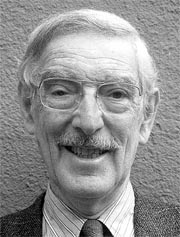 Bruce Ames, PhD
Bruce Ames, PhD
b. 1928 Hall of Fame 2010 Bruce Ames is a professor of Biochemistry and Molecular Biology at the University of California, Berkeley, and a senior scientist at Children’s Hospital Oakland Research Institute. In the 1950s, Ames began working at the NIH, where he investigated ways of mutating the DNA of bacteria in order to learn more about gene regulation. This work led him to develop the “Ames Test,” one of the key diagnostic tools for detecting mutagens that is still used worldwide. With that breakthrough test, Ames and other investigators were able to show that most cancer-causing chemicals act by damaging genes—a finding that now seems obvious only because Ames helped prove it. The revolution in the Ames Test was its speed and cost: it can be done in an afternoon, whereas previously animal cancer tests cost millions of dollars and took years to complete. Dr. Ames is a National Medal of Science winner, has published more than 450 scientific papers, and has become one of the most cited scientists alive. Ames has been interested in the “free radical theory of aging” for many years. Free radicals are highly reactive molecules that ravage cell machinery, bond indiscriminately with other molecules, break chromosomes and cripple enzymes. In 1990 Ames published the first evidence that DNA oxidation actually increases with age. This research led him to look more closely at mitochondria because they are a significant source of the body’s free radicals. In order to burn fats and carbohydrates to make metabolic fuel, mitochondria take electrons from NADH and shuffle them among a suite of molecules in a complex chain reaction, ending in the reduction of oxygen to water. Invariably, some of the electrons escape from this "respiratory chain", creating free radicals. His breakthrough in aging research, which came in the mid-1990s, took a closer look at a dietary supplement, acetyl-L-carnitine (ALCAR). Ames reasoned that high levels of ALCAR might also combat the problems of aging membranes and decrepit enzymes. He began feeding ALCAR to his old rats and within weeks, he noticed improvements in the animals’ biochemistry and behaviour. Their mitochondria were going full bore again, and they had become far more active, they were still churning out oxidants at a very high rate. Ames decided to add an agent to the rats’ diet to neutralize the oxidants. He tried lipoic acid, a mitochondrial antioxidant. The results were profound. Oxidants and oxidative damage to mitochondrial components dropped dramatically. Both the structure and function of the mitochondria improved. Three years ago, Ames set up a company called Juvenon, which sells tablets containing 200 mg alpha-lipoic acid and 500 mg acetyl-L-carnitine, to be taken twice a day. Ames is also convinced that simple B vitamin therapy could combat many diseases, and has published an exhaustive review, with more than 300 references, showing that no fewer than 50 genetic diseases might be remedied with high doses of vitamins, minerals, and amino acids. Most recently, he has published on his novel "triage theory", which posits that some functions of micronutrients are restricted during shortage and that functions required for short-term survival take precedence.
|